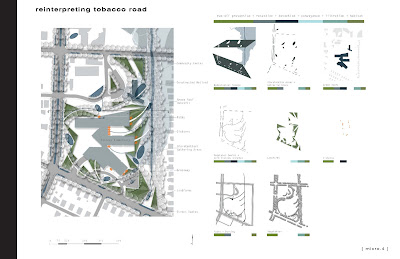re-compose
The meaning of death and dying is ambiguous. Death can be considered neither an end point nor a beginning. Death can represent creation and destruction. It is a natural process that at times is debilitating to the living and at other times inspiring. The concept for the landscape design project re-compose is to illuminate a natural process, decomposition of a tree, that frames death and dying with optimism and highlights the universal and timeless funerary rituals of how man responds and copes with loss.
A great deal of mankind’s greatest recognizable markings have come in the form of a memorial. These memorials share many common traits. As society progressed, these traits reflected a growing understanding of mathematics, engineering, art and design. Strong geometries once based on celestial movements were all but cast aside as the contemporary cemetery often relies on the English Landscape notions of superimposed geometric grids of gravestones surrounded by large trees, manicured grass, and gently winding paths. For our solution, we looked for a way to supersede the idea of the English Garden Memorial with a deeper understanding and reverence for the ecological benefits of the wilderness.
As the first step of our woodland intervention, we replace the grid of gravestones with a grid of trees. Within that grid, a new composition of the stone pieces is arranged to create a social space for the living to celebrate the act of remembrance, as the space itself harkens to the somber notion of a traditional memorial. The stones are wrapped in timbers to create a biotic and abiotic sculpture that displays the fruitful process of decomposition of a fallen tree by fungi that in time will disintegrate and unearth stone.
At the interface between the proposed intervention and the existing woodland, native herbaceous species will be planted as a “white garden” to provide 3 important functions:



A great deal of mankind’s greatest recognizable markings have come in the form of a memorial. These memorials share many common traits. As society progressed, these traits reflected a growing understanding of mathematics, engineering, art and design. Strong geometries once based on celestial movements were all but cast aside as the contemporary cemetery often relies on the English Landscape notions of superimposed geometric grids of gravestones surrounded by large trees, manicured grass, and gently winding paths. For our solution, we looked for a way to supersede the idea of the English Garden Memorial with a deeper understanding and reverence for the ecological benefits of the wilderness.
As the first step of our woodland intervention, we replace the grid of gravestones with a grid of trees. Within that grid, a new composition of the stone pieces is arranged to create a social space for the living to celebrate the act of remembrance, as the space itself harkens to the somber notion of a traditional memorial. The stones are wrapped in timbers to create a biotic and abiotic sculpture that displays the fruitful process of decomposition of a fallen tree by fungi that in time will disintegrate and unearth stone.
At the interface between the proposed intervention and the existing woodland, native herbaceous species will be planted as a “white garden” to provide 3 important functions:
- Create a social space for remembrance based on a heightened understanding of ecological function
- To illuminate the forest with a halo of native white flowers amongst the otherwise dappled darkness of the woodland; and,
- To “seal the edge” by preventing opportunities for invasive species to proliferate at the disturbed edge


































